Active solder, S-Bond® alloys have been developed to bond to a range of metals, ceramics and composite materials without the need for fluxes of preplating. In particular, such active solder alloys have an affinity for joining aluminum to itself and other metals and ceramics. Aluminum soldering has gotten simpler with the emergence of such S-Bond® solders. Just melt the S-Bond filler metals, mechanically spread them on the surface via brushing, rubbing, or via ultrasonically activated spreaders and the alloys will wet, adhere and provide a base for bonding. In a subsequent step, when two molten pre-tinned S-Bond layers are pressed or slid together the S-Bond layers will activate a strong solder bond.
Advantages of S-Bond Aluminum Soldering
• Lower temperature bonding (from 120 – 250°C) lowers thermal expansion mismatch issues.
• Permits the joining of aluminum to copper and other metals and ceramics, provided thermal expansion mismatch is managed in the component design.
• An S-Bond ( solder) metallic joint provide thermally conductive bonded interfaces
• No additional metal plating is required to prepare aluminum surfaces is needed, lowering preparation costs.
• Flux free joining assures nearly 100% bond areas and eliminates aggressive acid fluxes and creates cleaner work environments.
• Eliminates post bond cleaning to remove flux and associated waste water.
• Joints offer repair and re-manufacture since solders remelt at temperatures much below aluminum melting temperatures.
Applications where S-Bond shows its advantages include a wide range of thermal management components (finned heat exchangers, cold plates, and heat spreaders). Figures 1 – 4 illustrates just some of the many successful examples.
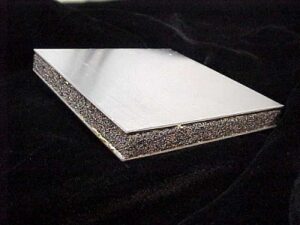

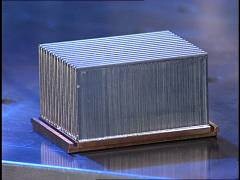
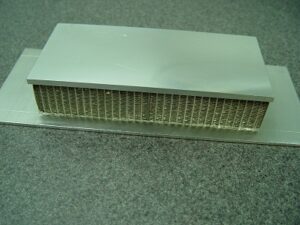
Figure 5 and 6 illustrates typical S-Bond filler application methods for preparing to bond aluminum. The figures illustrate that rubbing and/or brushing can be used to spread and wet S-Bond to aluminum surfaces.
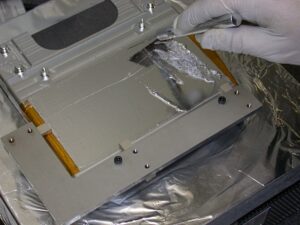
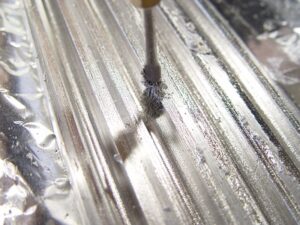
Aluminum soldering presents a challenge since the corrosion resistance of aluminum depends on aluminum’s naturally forming oxide (Al2O3) skin. This “nascent” oxide skin exists and reforms on all aluminum alloys and is a natural barrier to corrosion and also to metallic bonding. Soldering, brazing and even welding all must have means to either disrupt this thin aluminum oxide skin before wetting and metallurgical adherence can be generated. In welding A/C high frequency pulses on a DC arc will alternate polarity and disrupt and clean the aluminum as it welds. In brazing, chemical fluxes (fluoride base acids) as spray on or in surfaces of immersion dip brazing baths, fluxing in controlled atmospheres, or vacuum brazing (with Mg present) is used to disrupt aluminum oxide layers just prior to the molten aluminum braze filler flowing on the cleaned joint surfaces.
In aluminum soldering, the lowest temperature for the metallic joining process is (150 – 450°C), either very aggressive fluoride base acidic fluxes are used to disrupt the oxide as the solder wets and adheres to the freshly clean aluminum surface. Alternatively, nickel plate is applied to cover the oxide skin with a metallic layer that has a less stable oxide which can be disrupted with less aggressive fluxes and the molten solder can subsequently wet, flow and adhere to the nickel plated surface.
Patented S-Bond® active solder fillers that have been formulated using active element such as Ti, Mg, rare earth metals, and/or gallium to Sn, SnAl, SnZn, Sn-Ag, SnAgBi, SnAgIn or even PbSn base solders. These solders are then active enough to react with and through the aluminum’s oxide layers and react with the underlying “fresh” aluminum surface to form reaction zones which are the basis of forming strong chemical bonds with the aluminum surfaces. Figure 7 illustrates those type bonds and Figure 8 shows an actual metallographic image of an aluminum / S-Bond interface showing a reaction bond zone where Al-Ag phases have chemically formed.

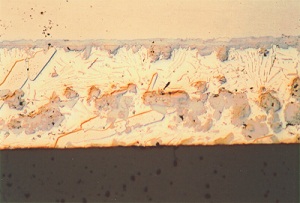
Highly active S-Bond active solders do require additional “mechanical activation” as shown in Figures 1 and 2. Such mechanical means of spreading the alloy disrupts the natural oxides that form on the molten S-Bond layer. The oxides that form on Sn-Ag-Ti + Ce S-Bond alloys as they melt are cerium oxide modified films which are more tenacious/stable than the tin oxides that normally would form on molten Sn-Ag solders.
So, S-Bond alloys are a new class of solder filler metal, but also they also require new processing methods for effective aluminum soldering. The processes all involve mechanical “activation” or agitation of the S-Bond filler layers as they are pre-placed on the aluminum surfaces and the molten S-Bond layers are subsequently joined to each other to complete the bonded surface. Figure 9 illustrates ultrasonic spreading of the molten active solders onto large aluminum surfaces prior to the molten surface being placed against one another. Figure 10 shows the placement of two S-Bond “pre-tinned” molten surfaces over one another by sliding, to eliminate air from a large interface that required no voids to maintain low thermal resistance since it was a heat exchange plate for cooling automotive electronics.
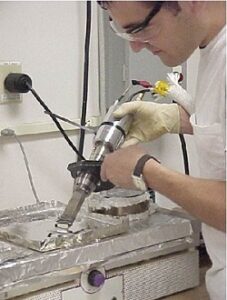
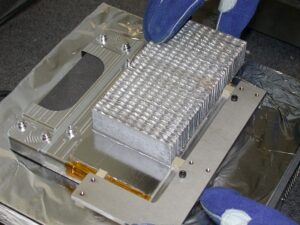
An important note: S-Bond alloys will not “reflow” or flow via capillary action into joints or flow over surfaces that have not been “pre-tinned” using mechanical activation means. Therefore, different solder joining techniques that incorporate mechanical disruption must be incorporated into S-Bond aluminum bonding processes. At first glance this behavior of S-Bond appears a limitation, BUT on the other hand a molten solder that will not flow into adjacent surfaces can be a major advantage in joining enclosures, metallic foams and intricate surfaces where excess solder flow can is not desired. A major advantage: S-Bond “stays where it is placed”…
S-Bond aluminum soldering really shows its value when…
• Thermally conductive, low void joints are needed
• Fluxing causes contamination
• Excess solder flow affects part function
• Dissimilar materials are being joined
• Reworkable joints are preferred
• Higher joint strengths are not required.
S-Bond Technologies has extensive experience in joining of aluminum in a wide range of applications and industries, please contact us to inquire how our S-Bond technology and experience can assist you with your applications.

4 Responses
Hi Srs,
I use today to solder aluminium 6061 a common flux(borax),but after of the welding the aluminium goes to be not clean surface.
Im very interested for the flux that you promote in those letters,please send me what type of flux is and the prices ,shipping to israel.
thanks and best regards.
javier.
Lower temperature bonding (from 120 – 250°C) lowers thermal expansion mismatch issues.
• Permits the joining of aluminum to copper and other metals and ceramics, provided thermal expansion mismatch is managed in the component design.
• An S-Bond ( solder) metallic joint provide thermally conductive bonded interfaces
• No additional metal plating is required to prepare aluminum surfaces is needed, lowering preparation costs.
• Flux free joining assures nearly 100% bond areas and eliminates aggressive acid fluxes and creates cleaner work environments.
• Eliminates post bond cleaning to remove flux and associated waste water.
• Joints offer repair and re-manufacture since solders remelt at temperatures much below aluminum melting temperatures
Our active solders work without flux. We do not use or sell flux. Click here for additional information on how our alloys work and go to our Contact Us page and inquire about our test kits, materials and services.
please contact us asap
[email protected]
+27832754970
We will contact you. Thank you for your inquiry